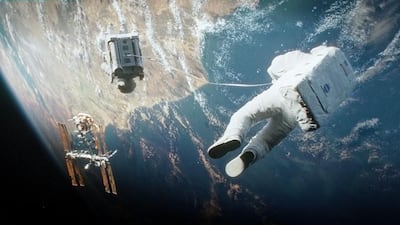While the recent hit US film Gravity referenced it, albeit dramatically, the space surrounding our home planet is a floating junkyard where debris abounds, moving at fantastic speeds with colossal destructive energy.
With its own valuable satellites in space, the UAE has good reason to be involved in researching space debris. Abu Dhabi’s Mubadala Yahsat satellites, Y1A and Y1B, cover over 140 countries and were launched in 2011 and 2012, respectively.
The launch of a third craft, which will help expand high-speed broadband operations, is set for the first half of this year. In addition, Dubai’s Thuraya Telecoms has launched three.
“We are ready for launch of our third satellite and have signed subscriber contracts in Brazil and Africa,” said the chief executive of Yahsat, Masood Sharif Mahmood.
At the Global Space Congress in Abu Dhabi that ended this month, Khalifa Mohamed Al Rumaithi, chairman of the UAE Space Agency, said the space sector was vital to the nation’s development, along with its efforts to achieve sustainable economic development through its space industry.
And space pollution poses an existential risk for the greater commercialisation of space.
In low-earth orbit, space debris travels at velocities approaching 8 kilometres per second – about 29,000kph – which gives even the smallest piece of detritus huge destructive energy. A one centimetre wide aluminium sphere in low-earth orbit packs the kinetic equivalent of a standard safe moving at about 100kph.
The UAE is well aware of the damaging potential of orbital junk. In 2015 The National reported how two Emirati scientists from the UAE Space Agency watched from 10km up as debris crashed to Earth at more than 38,000kph.
The scientists were among a group of 12 airborne observers from Nasa, the European Space Agency and the Abu Dhabi-based International Astronomy Centre studying the object, which was believed to be between one and three metres long and from a satellite, at an altitude of 13.7km.
"The space debris research is very important for the UAE because of the crowd of satellites around the Earth – and more are being added," Khaled Al Hashmi, the director of space missions management at the UAE Space Agency, who was on the flight, told The National.
“Such research helps prepare us for an early warning and to predict its impact,” Mr Al Hashmi said.
Researchers have begun modelling a variety of approaches to deal with space junk, including giant mesh tethers, harpoon systems and drag sails that increase the pull on a satellite to push it into Earth’s atmosphere more quickly where they burn up. “It’s very easy to get something into orbit and it’s the dickens to get it out,” Bill Ailor, a research fellow at The Aerospace Corp, which specialises in tracking space debris, told Bloomberg.
Aggregate too much debris in certain areas and low-earth orbit becomes an increasingly difficult and far costlier environment for commercial firms. Today, satellite operators periodically manoeuvre their spacecraft to avoid object strikes just as Nasa must do with the International Space Station, according to Bloomberg. The key, however, is knowing what is headed your way.
“Knowing where stuff is the first part of the problem,” said Mr Ailor. “Over the longer term we need to be getting much better [tracking] data so satellite operators don’t move unnecessarily.”
To that end, some entrepreneurs see profit potential in helping to better catalogue all that junk up there. One such firm is LeoLabs in California, which said on Monday it raised US$4 million from a group of investors, including Airbus Ventures, Bloomberg reported.
Also on Monday, LeoLabs said it has opened a second radar-tracking facility, in Texas, joining one in central Alaska. Ultimately, the company aims to have a half dozen such sites. LeoLabs says its two radar centres can track 95 percent of the 13,000 larger objects in low-earth orbit that the US defence department monitors. The company plans to track almost 250,000 objects as its radar network expands.
“Commercial space in low-earth orbit is growing so rapidly we really have to run quickly to keep up,” Dan Ceperley, LeoLabs’ chief executive, told Bloomberg.
Ultimately, governments will probably need to more closely regulate “best practices” for players operating in low-earth orbit, with rules mandating vehicle disposal and new funding for research into how to remove larger objects, Mr Ailor and Mr Ceperley said.
“It’s kind of like the Wild West,” Mr Ceperley said. “There’s this growing understanding that with more and more satellites going to space, [debris] could become a problem.”
In the end, the continuing success of the commercial space sector will be to a growing extent reliant on the cleanliness of that region of the sky 1,900km above the planet.
“It’s kind of the human way,” Mr Ailor said. “You look at the oceans or the environment or anything and you think it’s an infinite resource – and it isn’t.”
chnelson@thenational.ae
with Bloomberg
Follow The National's Business section on Twitter
with Bloomberg

